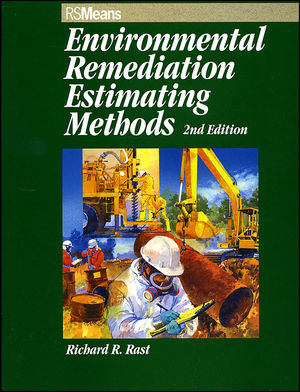Environmental Remediation Estimating Methods, 2nd EditionISBN: 978-0-87629-615-8
Hardcover
770 pages
December 2002
 This is a Print-on-Demand title. It will be printed specifically to fill your order. Please allow an additional 10-15 days delivery time. The book is not returnable.
|
||||||
Acknowledgments.
How to Use This Book.
Part I: The Remediation Process.
Chapter 1: Overview of Cost Engineering for Remediation Projects.
Chapter 2: Environmental Remediation Laws and Regulations.
Chapter 3: Remedial Action Cost Estimating Process.
Chapter 4: Types of Treatment and Treatment Trains.
Chapter 5: Treatment Technology Functional Groupings.
Chapter 6: Site Work and Utilities.
Chapter 7: Safety Levels.
Part II: Cost Estimating for Remediation—Treatment Technologies.
Chapter 8: Advanced Oxidation Processes.
Chapter 9: Air Sparging.
Chapter 10: Air Stripping.
Chapter 11: Bioventing.
Chapter 12: Carbon Adsorption—Gas.
Chapter 13: Carbon Adsorption—Liquid.
Chapter 14: Coagulation and Flocculation.
Chapter 15: Dewatering (Sludge).
Chapter 16: Ex Situ Bioreactors.
Chapter 17: Ex Situ Land Farming.
Chapter 18: Ex Situ Solidification/Stabilization.
Chapter 19: Ex Situ Soil Vapor Extraction.
Chapter 20: Heat-Enhanced Vapor Extraction.
Chapter 21: In Situ Biodegradation Saturated Zone.
Chapter 22: In Situ Land Farming.
Chapter 23: In Situ Solidification.
Chapter 24: Media Filtration.
Chapter 25: Metals Precipitation.
Chapter 26: Neutralization.
Chapter 27: Off-Site Transportation and Thermal Treatment.
Chapter 28: On-Site Low-Temperature Thermal Desorption.
Chapter 29: Passive Water Treatment.
Chapter 30: Phytoremediation.
Chapter 31: Soil Flushing.
Chapter 32: Soil Vapor Extraction.
Chapter 33: Soil Washing.
Chapter 34: Solvent Extraction.
Chapter 35: Thermal and Catalytic Oxidation.
Part III: Cost Estimating for Remediation—Containment Technologies.
Chapter 36: Capping.
Chapter 37: Permeable Barriers.
Chapter 38: Slurry Walls.
Chapter 39: Underground Storage Tank Closure.
Part IV: Cost Estimating for Remediation – Removal Technologies.
Chapter 40: Drum Staging.
Chapter 41: Excavation.
Chapter 42: Free Product Removal (French Drain).
Chapter 43: Groundwater Extraction Wells.
Chapter 44: Transportation.
Part V: Cost Estimating for Remediation – Discharge Technologies.
Chapter 45: Discharge to POTW.
Chapter 46: Infiltration Gallery.
Chapter 47: Injection Wells.
Part VI: Cost Estimating for Remediation—Disposal Technologies.
Chapter 48: Off-Site Transportation and Waste Disposal.
Chapter 49: Residual Waste Management.
Part VII: Cost Estimating for Remediation—Ordnance Technologies.
Chapter 50: Ordnance and Explosives Removal Action.
Chapter 51: UXO Active Target Clearance.
Part VIII: Cost Estimating for Remediation—Radioactive Waste Technologies.
Chapter 52: Dismantling Contaminated Building Materials.
Chapter 53: Decontamination and Decommissioning Sampling and Analysis.
Chapter 54: In Situ Vitrification.
Chapter 55: Surface Decontamination.
Part IX: Cost Estimating for Remediation—Remediation Support.
Chapter 56: Groundwater Monitoring Wells.
Chapter 57: Monitoring.
Chapter 58: Remedial Action Professional Labor Management.
Chapter 59: Remedial Design.
Part X: Cost Estimating for Remediation—Operations and Maintenance.
Chapter 60: Cost Estimating for Remediation Operations and Maintenance.
Part XI: Remediation Work Breakdown Structures.
Chapter 61: Remediation Work Breakdown Structures.
Part XII: Determining Contractor Costs.
Chapter 62: Contractor’s General Conditions.
Chapter 63: Contractor Overhead and Profit.
Chapter 64: Determining Contractor Markups: Percentage Method.
Glossary.
References.
Index.



